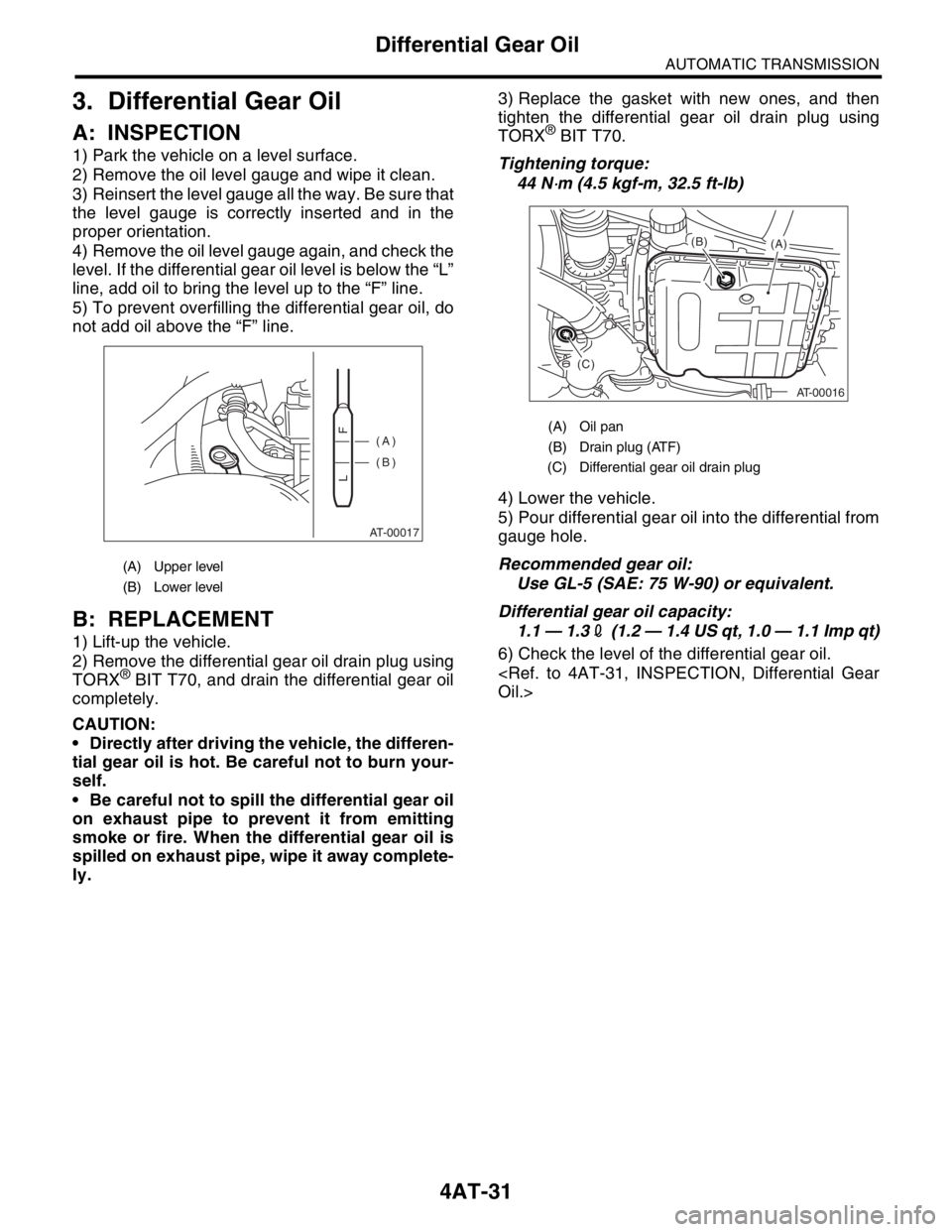2004 SUBARU FORESTER check oil
[x] Cancel search: check oilPage 2085 of 2870

EN(H4DOTC 2.5)-61
ENGINE (DIAGNOSTIC)
Diagnostics for Engine Starting Failure
6 CHECK HARNESS BETWEEN ECM AND IG-
NITION COIL & IGNITOR ASSY CONNEC-
TOR.
Measure the resistance of harness between
ECM and engine ground.
Connector & terminal
(B135) No. 15 — Engine ground:
(B135) No. 16 — Engine ground:
(B135) No. 17 — Engine ground:
(B135) No. 18 — Engine ground:Is the resistance more than 1
MΩ?Go to step 7.Repair ground
short circuit in har-
ness between
ECM and ignition
coil & ignitor ASSY
connector.
7 CHECK POOR CONTACT.
Check poor contact in ECM connector.Is there poor contact in ECM
connector?Repair the poor
contact in ECM
connector.Check fuel pump
circuit.
62, FUEL PUMP
CIRCUIT, Diag-
nostics for Engine
Starting Failure.> Step Check Yes No
Page 2241 of 2870

EN(H4DOTC 2.5)-217
ENGINE (DIAGNOSTIC)
Diagnostic Procedure with Diagnostic Trouble Code (DTC)
Step Check Yes No
1 CHECK HARNESS BETWEEN ECM AND OIL
FLOW CONTROL SOLENOID VALVE.
1) Turn the ignition switch to OFF.
2) Disconnect the connector from ECM and oil
flow control solenoid valve.
3) Measure the resistance between ECM and
oil flow control solenoid valve.
Connector & terminal
(B134) No. 18 — (E38) No. 1:
(B134) No. 28 — (E38) No. 2:Is the resistance less than 1
Ω?Go to step 2.Repair open circuit
in harness between
ECM and oil flow
control solenoid
valve connector.
N
OTE:
In this case, repair
the following
Open circuit in
harness between
ECM and oil flow
control solenoid
valve connector
Poor contact in
coupling connector
2 CHECK HARNESS BETWEEN ECM AND OIL
FLOW CONTROL SOLENOID VALVE.
Measure the resistance between oil flow con-
trol solenoid valve and engine ground.
Connector & terminal
(E38) No. 1 — Engine ground:
(E38) No. 2 — Engine ground:Is the resistance more than 1
MΩ?Go to step 3.Repair short circuit
between ECM and
oil flow control
solenoid valve
connector.
3 CHECK OIL FLOW CONTROL SOLENOID
VALVE.
1) Remove the oil flow control solenoid valve
connector.
2) Measure the resistance between oil flow
control solenoid valve terminals.
Te r m i n a l s
No. 1 — No. 2:Is the resistance 6 — 12 Ω? Repair poor con-
tact in ECM and oil
flow control sole-
noid valve.Replace the oil
flow control sole-
noid valve.
68, Camshaft.>
Page 2243 of 2870

EN(H4DOTC 2.5)-219
ENGINE (DIAGNOSTIC)
Diagnostic Procedure with Diagnostic Trouble Code (DTC)
Step Check Yes No
1 CHECK HARNESS BETWEEN ECM AND OIL
FLOW CONTROL SOLENOID VALVE.
1) Turn the ignition switch to OFF.
2) Disconnect the connector from ECM and oil
flow control solenoid valve.
3) Measure the resistance between ECM and
oil flow control solenoid valve.
Connector & terminal
(B134) No. 18 — (E38) No. 1:
(B134) No. 28 — (E38) No. 2:Is the resistance less than 1
Ω?Go to step 2.Repair open circuit
in harness between
ECM and oil flow
control solenoid
valve connector.
N
OTE:
In this case, repair
the following
Open circuit in
harness between
ECM and oil flow
control solenoid
valve connector
Poor contact in
coupling connector
2 CHECK HARNESS BETWEEN ECM AND OIL
FLOW CONTROL SOLENOID VALVE.
1) Turn the ignition switch to OFF.
2) Disconnect the connector from ECM and oil
flow control solenoid valve.
3) Measure the resistance between oil flow
control solenoid valve and engine ground.
Connector & terminal
(E38) No. 1 — Engine ground:
(E38) No. 2 — Engine ground:Is the resistance more than 1
MΩ?Go to step 3.Repair short circuit
between ECM and
oil flow control
solenoid valve
connector.
3 CHECK OIL FLOW CONTROL SOLENOID
VALVE.
1) Remove the oil flow control solenoid valve
connector.
2) Measure the resistance between oil flow
control solenoid valve terminals.
Te r m i n a l s
No. 1 — No. 2:Is the resistance 6 — 12 Ω? Repair poor con-
tact in ECM and oil
flow control sole-
noid valve.Replace the oil flow
control solenoid
valve.
Camshaft.>
Page 2245 of 2870

EN(H4DOTC 2.5)-221
ENGINE (DIAGNOSTIC)
Diagnostic Procedure with Diagnostic Trouble Code (DTC)
Step Check Yes No
1 CHECK HARNESS BETWEEN ECM AND OIL
FLOW CONTROL SOLENOID VALVE.
1) Turn the ignition switch to OFF.
2) Disconnect the connector from ECM and oil
flow control solenoid valve.
3) Measure the resistance between ECM and
oil flow control solenoid valve.
Connector & terminal
(B134) No. 19 — (E37) No. 1:
(B134) No. 29 — (E37) No. 2:Is the resistance less than 1
Ω?Go to step 2.Repair open circuit
in harness
between ECM and
oil flow control
solenoid valve
connector.
N
OTE:
In this case, repair
the following
Open circuit in
harness between
ECM and oil flow
control solenoid
valve connector
Poor contact in
coupling connector
2 CHECK HARNESS BETWEEN ECM AND OIL
FLOW CONTROL SOLENOID VALVE.
Measure the resistance between oil flow con-
trol solenoid valve and engine ground.
Connector & terminal
(E37) No. 1 — Engine ground:
(E37) No. 2 — Engine ground:Is the resistance more than 1
MΩ?Go to step 3.Repair short circuit
between ECM and
oil flow control
solenoid valve
connector.
3 CHECK OIL FLOW CONTROL SOLENOID
VALVE.
1) Remove the oil flow control solenoid valve
connector.
2) Measure the resistance between oil flow
control solenoid valve terminals.
Te r m i n a l s
No. 1 — No. 2:Is the resistance 6 — 12 Ω? Repair poor con-
tact in ECM and oil
flow control sole-
noid valve.Replace the oil
flow control sole-
noid valve.
68, Camshaft.>
Page 2247 of 2870

EN(H4DOTC 2.5)-223
ENGINE (DIAGNOSTIC)
Diagnostic Procedure with Diagnostic Trouble Code (DTC)
Step Check Yes No
1 CHECK HARNESS BETWEEN ECM AND OIL
FLOW CONTROL SOLENOID VALVE.
1) Turn the ignition switch to OFF.
2) Disconnect the connector from ECM and oil
flow control solenoid valve.
3) Measure the resistance between ECM and
oil flow control solenoid valve.
Connector & terminal
(B134) No. 19 — (E37) No. 1:
(B134) No. 29 — (E37) No. 2:Is the resistance less than 1
Ω?Go to step 2.Repair open circuit
in harness between
ECM and oil flow
control solenoid
valve connector.
N
OTE:
In this case, repair
the following
Open circuit in
harness between
ECM and oil flow
control solenoid
valve connector
Poor contact in
coupling connector
2 CHECK HARNESS BETWEEN ECM AND OIL
FLOW CONTROL SOLENOID VALVE.
1) Turn the ignition switch to OFF.
2) Disconnect the connector from ECM and oil
flow control solenoid valve.
3) Measure the resistance between oil flow
control solenoid valve and engine ground.
Connector & terminal
(E37) No. 1 — Engine ground:
(E37) No. 2 — Engine ground:Is the resistance more than 1
MΩ?Go to step 3.Repair short circuit
between ECM and
oil flow control
solenoid valve
connector.
3 CHECK OIL FLOW CONTROL SOLENOID
VALVE.
1) Remove the oil flow control solenoid valve
connector.
2) Measure the resistance between oil flow
control solenoid valve terminals.
Te r m i n a l s
No. 1 — No. 2:Is the resistance 6 — 12 Ω? Repair poor con-
tact in ECM and oil
flow control sole-
noid valve.Replace the oil
flow control sole-
noid valve.
68, Camshaft.>
Page 2283 of 2870

EN(H4DOTC 2.5)-259
ENGINE (DIAGNOSTIC)
General Diagnostic Table
*1: Check ignition coil & ignitor ASSY and spark plug.
*2: Indicate the symptom occurring only in cold temperatures.
*3: Ensure the secure installation.
*4: Check fuel injector, fuel pressure regulator and fuel filter.
*5: Inspect air leak in air intake system. 7. Spark knock1) Manifold absolute pressure sensor
2) Mass air flow and intake air temperature sensor
3) Engine coolant temperature sensor
4) Knock sensor
5) Fuel injection parts (*4)
6) Fuel pump and fuel pump relay
8. After burning in exhaust system1) Manifold absolute pressure sensor
2) Mass air flow and intake air temperature sensor
3) Engine coolant temperature sensor (*2)
4) Fuel injection parts (*4)
5) Fuel pump and fuel pump relay Symptom Problem parts
Page 2342 of 2870

4AT-30
AUTOMATIC TRANSMISSION
Automatic Transmission Fluid
2. Automatic Transmission Flu-
id
A: INSPECTION
NOTE:
The level of ATF varies with fluid temperature. Pay
attention to the ATF temperature when checking
ATF level.
1) Raise the ATF temperature by driving a distance
of 5 to 10 km (3 to 6 miles). Otherwise, idle the en-
gine to raise ATF temperature to 70 — 80°C (158
— 176°F) on Subaru Select Monitor.
TION, Subaru Select Monitor.>
2) Make sure the vehicle is level.
3) After selecting all positions (P, R, N, D, 3, 2, 1),
set the select lever in “P” range. Measure the ATF
level with engine idling for one or two minutes.
4) Make sure that ATF level is above the center of
upper level and lower level at HOT side.
If the ATF level is below the lower level, check for
leaks in the transmission. If there are leaks, it is
necessary to repair or replace gasket, oil seals,
plugs or other parts.
5) If the ATF level is below the center between up-
per level and lower level, add the recommended
ATF until the fluid level is found above the center
between upper level and lower level marks.
CAUTION:
Use care not to exceed the upper level.
Remember that the addition of ATF to the up-
per limit mark when the transmission is cold
will overfilling of ATF, causing a transmission
failure.
6) Check ATF level after raising ATF temperature
to 70 — 80°C (158 — 176°F) by running the vehicle
or by idling the engine again.
B: REPLACEMENT
1) Lift-up the vehicle.2) Drain the ATF completely.
CAUTION:
Directly after the engine has been running, the
ATF is hot. Be careful not to burn yourself.
3) Replace the gasket with new one, and then tight-
en the drain plug (ATF).
Tightening torque:
25 N
⋅m (2.5 kgf-m, 18.1 ft-lb)
4) Lower the vehicle.
5) Pour ATF from the ATF charge pipe.
Recommended fluid:
DEXRON III type automatic transmission flu-
id
Capacity:
Fill the same amount of ATF drained from
drain plug hole.
CAPACITY WHEN TRANSMISSION IS OVER-
HAULED:
2.0 L NON-TURBO MODEL
8.4 — 8.72 (8.9 — 9.2 US qt, 7.4 — 7.7 Imp
qt)
EXCEPT 2.0 L NON-TURBO MODEL
9.3 — 9.62 (9.8 — 10.1 US qt, 8.2 — 8.4 Imp
qt)
6) Check the level and leaks of ATF.
(A) ATF level gauge
(B) Upper level
(C) Lower level
AT-00674
COLD
LFHOT LF
(C)
(C)
(B)
(B)
(A)(A) Oil pan
(B) Drain plug (ATF)
(C) Differential gear oil drain plug
AT-00016
(A) (B)
(C)
Page 2343 of 2870

4AT-31
AUTOMATIC TRANSMISSION
Differential Gear Oil
3. Differential Gear Oil
A: INSPECTION
1) Park the vehicle on a level surface.
2) Remove the oil level gauge and wipe it clean.
3) Reinsert the level gauge all the way. Be sure that
the level gauge is correctly inserted and in the
proper orientation.
4) Remove the oil level gauge again, and check the
level. If the differential gear oil level is below the “L”
line, add oil to bring the level up to the “F” line.
5) To prevent overfilling the differential gear oil, do
not add oil above the “F” line.
B: REPLACEMENT
1) Lift-up the vehicle.
2) Remove the differential gear oil drain plug using
TORX
® BIT T70, and drain the differential gear oil
completely.
CAUTION:
Directly after driving the vehicle, the differen-
tial gear oil is hot. Be careful not to burn your-
self.
Be careful not to spill the differential gear oil
on exhaust pipe to prevent it from emitting
smoke or fire. When the differential gear oil is
spilled on exhaust pipe, wipe it away complete-
ly.3) Replace the gasket with new ones, and then
tighten the differential gear oil drain plug using
TORX
® BIT T70.
Tightening torque:
44 N
⋅m (4.5 kgf-m, 32.5 ft-lb)
4) Lower the vehicle.
5) Pour differential gear oil into the differential from
gauge hole.
Recommended gear oil:
Use GL-5 (SAE: 75 W-90) or equivalent.
Differential gear oil capacity:
1.1 — 1.32 (1.2 — 1.4 US qt, 1.0 — 1.1 Imp qt)
6) Check the level of the differential gear oil.
(A) Upper level
(B) Lower level
AT-00017
(A)
(B)
LF
(A) Oil pan
(B) Drain plug (ATF)
(C) Differential gear oil drain plug
AT-00016
(A) (B)
(C)